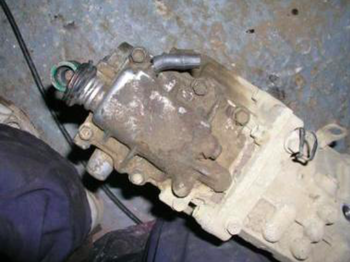Jump to navigation
Jump to search
![]() The content of any article might be expanded / improved in the future - revisit it sometimes.
The content of any article might be expanded / improved in the future - revisit it sometimes.
![]() Seen a mistake? Know something that isn't written? Edit and change this article yourself!
Seen a mistake? Know something that isn't written? Edit and change this article yourself!
![]() Some images in the article (if present) can be enlarged by clicking on them.
Some images in the article (if present) can be enlarged by clicking on them.
Contents
Introduction
- Jimny's axles, gear box and transfer box have small caps which serve as air breathers.
- They allow the air to come in if the oil inside cools (and contracts) rapidly (for example when the vehicle dips into deep mud or water).
- However, there is a risk of that mud or water coming inside through those breathers, fouling the oil and causing expensive damage.
- Therefore, it is very advisable to install extended breathers at least on front and rear axles.
- The "extended breathers" are nothing more than rubber hoses!
- They are dead simple to install.
- Installing them on a transfer case (and especially on the gear box) is more complicated.
- The reason is that the gear box and the transfer case have to be dismounted first, and this is not a trivial task at all!
- There is a much lower risk that a water would get over them anyway.
Installing the breathers on the axles
- To install extended axle breathers on the axles, just buy a good quality rubber hose (approx 6-7 m of length) with internal diameter of 1/2", and a few good quality metal screw-tight straps for hoses.
- Forcibly remove factory breather caps from the axle differential housings and put on the rubber hoses, and tighten the metal straps on the connection point.
- Lay the hoses through the underbody, in the engine bay, up to the bonnet height, avoiding hot surfaces.
- You do not even strictly need a "T" hose connector for interconnecting the two axles, as each hose can go independently up to the top.
- Tie the hoses here and there with plastic strap ties, and leave enough extra slack hose near the axles, because the axles move up and down during usage.
- Also leave a bit extra hose length at the top, so that you can "curl" the tops of the hoses back down. This will prevent the ingress of water through the hoses in case when power washing the vehicle.
- It isn't a bad idea to stuff some very thin (breathable) cloth (like a band aid material) in the tops of the hoses, to prevent ingress of dirt and insects inside.
- During usage, check the hoses now and then in case that they are starting to come off at the axle connection point.
- You DO NOT want them to separate from the axles, as that will leave a gaping hole for anything to enter the axles.
Installing the breathers on transfer case
- This procedure is best done when the transfer case is dismounted anyway for some other maintenance work.
- Check this article for some ideas on how to do it.
More on the specific solutions to be written later on ...
Installing the breathers on the gear box
This procedure is best done when the gear box is dismounted anyway for some other maintenance work (for example, changing the clutch).
- The picture shows the rubber pipe that is the normal breather (minus a plastic cap which had already fallen off!).
- The later gear box models have an extended breather already.
- An extended breather is another good candidate for slipping between the gear box and engine while you are trying to refit the gear box back into its position.
- Simply slide some pipe onto the tub and extend the breather to a higher point on the car.
Page last edited on 21/02/2019 by user Bosanek

